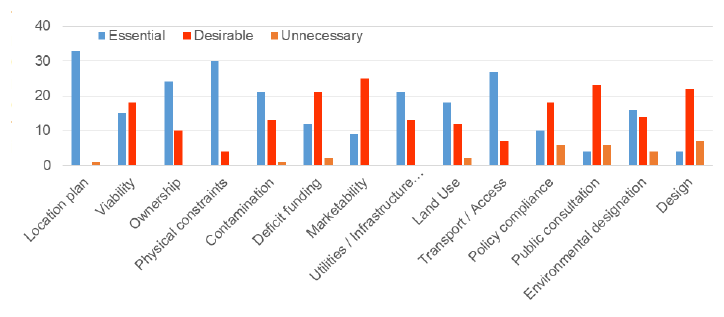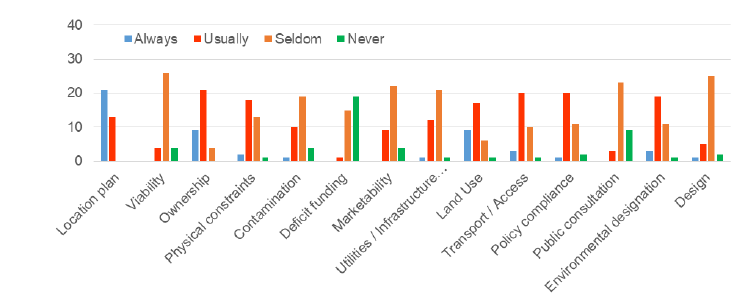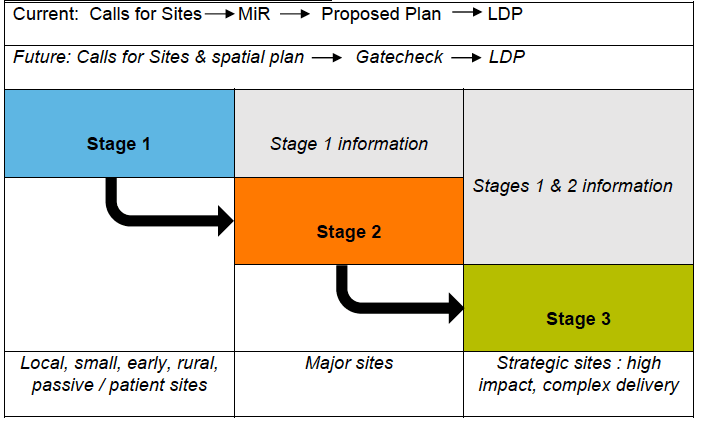Local development plans - deliverability of site allocations: research
Research considering the types of proportionate information that will demonstrate a development site’s deliverability.
Executive Summary
The Scottish Government instructed Ryden LLP, supported by Brodies LLP, to research the deliverability of site allocations in Local Development Plans (LDPs). The research considers the types of proportionate information that will demonstrate a development site’s deliverability.
Deliverability has come into greater focus in Scottish planning policy. NPF3 and SPP2 advocate “a sharp focus on the delivery of allocated sites”. The independent review of the Scottish planning system (May 2016), Empowering Planning to Deliver Great Places, confirmed the vital role which deliverability plays in successful planning. Proposal 5: Making plans that deliver, in the Scottish Government’s consultation paper ‘People, Places & Planning’ (January 2017) advocated a focus on providing greater confidence on the effectiveness of sites and when they can be delivered, including appraisal of information before any site is allocated. Consultation responses agreed that plans would be strengthened by setting out the information required to accompany proposed site allocations. The Scottish Government’s Position Statement on ‘People, Places & Planning’ (June 2017) noted that establishing development viability is essential to securing greater certainty of delivery.
An online survey secured a 100% response rate from the 32 Scottish local development planning authorities and 2 National Park planning authorities.
The survey identified that assessing sites information is a qualified and experienced planning role. Site deliverability is assessed by Development Planning teams, supported by Development Management, other local authority departments, key agencies and other third party organisations. Site allocation proposals are predominantly requested before preparing the Main Issues Report.
Planning authorities require a range of information (see first chart below) to assess deliverability. Mainly this is to inform whether a site is potentially physically deliverable, or faces one or more major constraints. Market information, policy compliance, public consultation and design are typically ‘desirable’ rather than ‘essential’. The current focus is thus upon the initial deliverability of development land through assessment of constraints, and much less so upon the subsequent deliverability of development.
There is a major and consistent gap between these site assessment information requirements and the information typically provided by site promoters (see second chart below). Information on physical constraints is ‘usually’ or ‘seldom’ provided, and market information ‘seldom’. Information categories mirroring PAN 2/2010s’ effectiveness criteria for housing are ‘usually’ or ‘seldom’ provided by site promoters at the allocation stage. Small Towns and Rural planning authorities receive less applicant information on site constraints than other authorities.
There is a major and consistent gap between these site assessment information requirements and the information typically provided by site promoters (see second chart below). Information on physical constraints is ‘usually’ or ‘seldom’ provided, and market information ‘seldom’. Information categories mirroring PAN 2/2010s’ effectiveness criteria for housing are ‘usually’ or ‘seldom’ provided by site promoters at the allocation stage. Small Towns and Rural planning authorities receive less applicant information on site constraints than other authorities


Some planning authorities use this information provided to populate a sites assessment matrix. This can also apply to current LDP allocations. Matrices can identify information gaps and form the basis for further information requests.
Site assessments by planning authorities share similar criteria, but the sieve order and weighting – by market factors, physical capacity/constraints, or spatial plan priorities – are not consistent, and could potentially influence the short-listing and thus the allocation of sites.
Assessing site deliverability for LDPs is evolving towards greater upfront investigation across a wider range of site-specific matters with other services, agencies, promoters and communities. The process is however moving at different speeds and in different ways across the country. The clearest differences are in the prominence which development viability and marketability are afforded.
The main constraints on improving sites assessment information cited by planning authorities are resources and specialist skills. As information front-loading gathers pace, both the volume and specialist nature of information present challenges for planning authorities, applicants (particularly non-developers) and third party agencies.
The large majority (82%) of planning authorities would support additional guidance on the information to be provided by site promoters seeking allocations in development plans. However, a significant minority (18%) would prefer that allocation of sites is assessed locally, and many who favour national guidance would also require local flexibility. Thus planning authorities are not necessarily asking for a rigid, mandatory approach to site assessment, but rather the weight and guidance of a standard approach which can retain the potential for local flexibility.
Cross-industry project consultations found that assessing deliverability – particularly viability - can be challenging during the early stages of considering sites, although understanding could be significantly improved. The vast majority of these sites are for housing. Planning authorities also encourage smaller developers and owners, alternative tenures, landowners and communities to promote and support sites. These targeted approaches are reportedly required in locations where there may be willing landowners and an end market for homes, but no willing developer promoting a site.
The focus on spatial planning varies at the site allocation stage. Some areas plan around site options, but weaker market areas can end up with a very limited choice favouring the “best promoted” sites.
The Main Issues Report process helps demonstrating site effectiveness and deliverability and allows time for a considered review. Community engagement is typically reported around the MIR rather than as part of the initial sites trawl, although some authorities use earlier community-based events to consult on options.
The link with LDP Action Programmes is reportedly weak at the sites assessment stage. Infrastructure capacity may be broadly understood, but investment options are not firm commitments and site-specific solutions may be lacking, particularly where there are cumulative impacts, and have later impacts upon viability and deliverability.
Based upon the research, a proportionate framework for assessing the deliverability of site allocations is proposed. It seeks to improve confidence in deliverability across different site types, uses, geographies, and from LDP allocation forwards through the planning system. The staged-and-scaled sites assessment applies as a site progresses through the planning system, and also proportionately to different sites.
Staged-and-Scaled Sites Assessment

Stage 1 (see full report Annex) is intended to provide sufficient information to conduct a sieve of promoted sites. It can also include sites from other sources such as existing allocations, planning authority allocations, community-led suggestions and unbuilt consents, planned disposals and demolitions, and can be used to quickly screen any gap sites or regeneration areas. The Stage 1 assessment includes site and promoter information, land use proposals, descriptions and proximity to facilities. It indicates a single link to relevant policy and infrastructure information on the LDP website.
Critically, the sites in this first sieve are intended to be subject to a spatial planning approach. Spatial planning would work symbiotically with market factors: a willing landowner; a willing developer or note of market potential; awareness of any policy requirements and infrastructure context; and confirmation that in these contexts the site is believed to be viable (or if not then there is a potential deficit funding solution).
Stage 1 can be a holding pool for: local / smaller sites (up to 50 houses or 2 hectares); some rural sites; employment/ commercial/ institutional sites in single ownership; sites held by patient but willing landowners with no developer yet committed; sites where interest has only recently been secured; and emerging public sector sites for regeneration. The aim is to avoid ‘pricing out’ sites which may have planning merit, but are not yet able or required to meet a higher hurdle for information and deliverability.
Stage 2 is intended for major sites (>50 houses / 2 hectares) promoted for development plan allocation. Information to support deliverability is added to become more specific. Major sites are on balance more likely to have a degree of complexity (and cost) of infrastructure investment, ownership, developer interest, development mix and phasing. A higher bar needs to be set for their deliverability, seeking evidence of deliverability.
The ‘major sites’ threshold is not prescriptive. Slightly smaller sites with potentially high or complex impacts, particularly cumulative, may also require Stage 2 assessment. Equally, some larger phased or regeneration sites may not yet require Stage 2 assessment. A local approach can be taken.
The main additions to the sites assessments at Stage 2 are: further information on the land use (eg. layout plans), development mix and anticipated phasing; any community engagement; site conditions; and market information to understand deliverability:
- for housing uses, target markets, formats, tenures and mix, and evidence of development viability via costs, values, fees & finance, profit margin, any deficit funding and anticipated land value
- for employment, institutional and commercial uses, potential target markets, user types and potential activity (eg. workers, customers, students, visitors) on site
Stage 3 sites assessment is proposed for ‘strategic allocations’. The largest formal definition in the planning system is ‘major’. However, much larger sites – eg. Strategic Development Areas, Community Growth Areas, Major Development Areas - are also allocated. Much of the uncertainty over their deliverability stems from their long term nature and ‘step change’ infrastructure requirements. Assessing the deliverability of these high cost, high impact allocations thus demands a much higher hurdle. This scaled approach to site assessment also supports a place-based approach to plan-making.
The Stage 3 amplified requirements are in only two areas: the benefits of the proposals; and viability assessment via a development appraisal incorporating costs, values, fees and finance, profit margin(s), deficit funding and the resulting residual land value. Independent verification of development appraisals may be required. Extreme caution will be required as later phases may not be confirmed in terms of development potential and funding solutions.
The research project Steering Group noted that strategic allocations could encourage a “co-production” between the promoter, planning authorities and their local authorities, infrastructure providers, agencies, statutory bodies and communities.
In addition to this staged-and-scaled approach, the research suggested a number of potential enhancements to the information technology functionality around site assessment: hyperlinks to policies, maps, agency and infrastructure information; binary (yes/no) field with data for aggregation and analysis; embedding this with planning authority GIS; and direct links to action programmes. Looking to the future, digital software models could help to determine whether allocations are optimum or not.
The recommended actions flowing from this research project are:
- The Scottish Government should review the ‘staged and scaled’ approach to sites assessment set out here and consider the extent to which that approach can provide greater confidence in the deliverability of site allocations.
- The approach requires to be tested in a pilot study, which should also consider integration of sites assessment information with the Action / Delivery Programme.
- The staged and scaled sites assessment requires to be appraised against the emerging reforms to the planning system.
- Further consideration is required of the protocols for requesting and using information from infrastructure agencies.
For site promoters, the resource implications should be modest up to Stage 2, where there is then front-loading of information requirements in comparison with some authorities’ current site assessment requirements. The exception is for viability, for which higher standards are suggested here at all stages of site assessment.
There are two potential ways to aggregate the process to achieve efficiencies for planning authorities: software solutions which could be adopted across authorities both to collate and assess sites information and link this to planning system portals and GIS; and sharing expertise and working across regional geographies such as housing market and transport areas could be considered.
Finally, if the Scottish Government decides to support a more standardised, staged and scaled approach to sites assessment for proposed allocations as set out in this report, then any pilot study could inform national guidance to be agreed with and rolled-out through Heads of Planning Scotland.
Contact
Email: Chief.Planner@gov.scot
There is a problem
Thanks for your feedback